
Bolivar County is a county located on the western border of the U.S. state of Mississippi. As of the 2010 census, the population was 34,145. Its county seats are Rosedale and Cleveland. The county is named in honor of Simón Bolívar, early 19th-century leader of the liberation of several South American colonies from Spain.
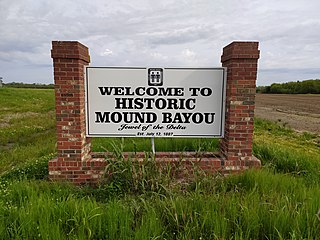
Mound Bayou is a city in Bolivar County, Mississippi, United States. The population was 1,533 at the 2010 census, down from 2,102 in 2000. It is notable for having been founded as an independent black community in 1887 by former slaves led by Isaiah Montgomery.

Pass Christian, nicknamed The Pass, is a city in Harrison County, Mississippi, United States. It is part of the Gulfport–Biloxi Metropolitan Statistical Area. The population was 6,307 at the 2019 census.

Fort Crawford was an outpost of the United States Army located in Prairie du Chien, Wisconsin, during the 19th century.
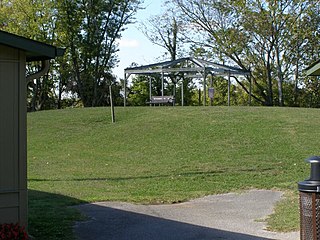
Wickliffe Mounds is a prehistoric, Mississippian culture archaeological site located in Ballard County, Kentucky, just outside the town of Wickliffe, about 3 miles (4.8 km) from the confluence of the Ohio and Mississippi rivers. Archaeological investigations have linked the site with others along the Ohio River in Illinois and Kentucky as part of the Angel Phase of Mississippian culture. Wickliffe Mounds is controlled by the State Parks Service, which operates a museum at the site for interpretation of the ancient community. Listed on the National Register of Historic Places, it is also a Kentucky Archeological Landmark and State Historic Site.

Theodore Roosevelt Mason Howard was an American civil rights leader, fraternal organization leader, entrepreneur and surgeon. He was among the mentors to activists such as Medgar Evers, Charles Evers, Fannie Lou Hamer, Amzie Moore, Aaron Henry, and Jesse Jackson; founded Mississippi's leading civil rights organization in the 1950s, the Regional Council of Negro Leadership; and played a prominent role in the investigation of the kidnapping and murder of Emmett Till in the late 1950s. He was also president of the National Medical Association, chairman of the board of the National Negro Business League, and a leading national advocate of African-American businesses.
The International Order of Twelve Knights and Daughters of Tabor is an African-American fraternal organization best known as the sponsor of the Taborian Hospital.
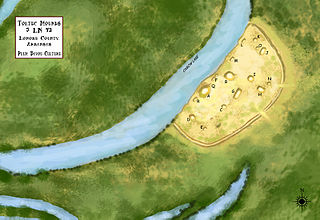
Toltec Mounds Archeological State Park, also known as Knapp Mounds, Toltec Mounds Site or Toltec Mounds, is an archaeological site from the Late Woodland period in Arkansas that protects an 18-mound complex with the tallest surviving prehistoric mounds in Arkansas. The site is on the banks of Mound Lake, an oxbow lake of the Arkansas River. It was occupied by its original inhabitants from 600 to 1050 CE. The site is designated as a National Historic Landmark.
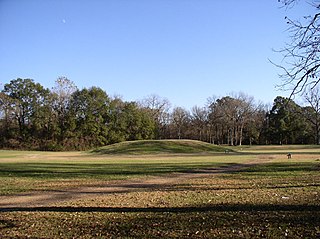
Grand Village of the Natchez, also known as the Fatherland Site, is a 128.1-acre (0.518 km2) site encompassing a prehistoric indigenous village and earthwork mounds in present-day south Natchez, Mississippi. The village complex was constructed starting about 1200 CE by members of the prehistoric Plaquemine culture. They built the three platform mounds in stages. Another phase of significant construction work by these prehistoric people has been dated to the mid-15th century. It was named for the historic Natchez people, who used the site in the 17th and 18th centuries.

The I. T. Montgomery House is a historic house on West Main Street in Mound Bayou, Mississippi, United States. Built in 1910, it was the home of Isaiah Montgomery (1847–1924), a former slave of Jefferson Davis who was instrumental in founding Mound Bayou, one of the first economically successful towns established by freed slaves. It was declared a National Historic Landmark in 1976, and a Mississippi Landmark in 2003.

The Winterville Site is a major archaeological site in unincorporated Washington County, Mississippi, north of Greenville and along the river. It consists of major earthwork monuments, including more than twelve large platform mounds and cleared and filled plazas. It is the type site for the Winterville Phase of the Lower Yazoo Basin region of the Plaquemine Mississippian culture. Protected as a state park, it has been designated as a National Historic Landmark.
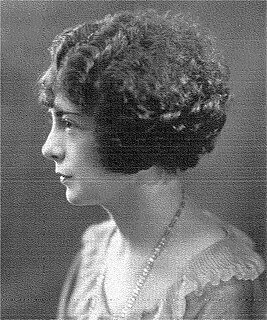
Carol Weld was an American journalist. She worked for various New York newspapers and as a foreign correspondent for news agencies in Paris. She was a founding member of the Overseas Press Club and collaborated with Frank Buck on Animals Are Like That.

The American Telephone & Telegraph Co. Building was a historic building located on the hill just north of downtown Davenport, Iowa, United States. It was listed on the National Register of Historic Places in 1983. The building has subsequently been torn down.
Matthew Walker Sr. was an American physician and surgeon. He was one of the first African Americans to become a Fellow of the American College of Surgeons. He was one of the most prominent Black doctors in the 20th century in the United States.

Caddo Mounds State Historic Site (41CE19) is an archaeological site in Weeping Mary, Texas. This Caddoan Mississippian culture site is composed of a village and ceremonial center that features two earthwork platform mounds and one burial mound. Located on an ancient Native American trail later named by the Spanish as El Camino Real de los Tejas, the settlement developed hundreds of years before the arrival of Europeans and Africans to the region. Archaeologists believe the site was created in approximately 800 CE, with most major construction taking place between 1100 and 1300 CE.

Gulfport Veterans Administration Medical Center Historic District, also known as Centennial Plaza, is a 48-acre (19 ha) compound located in Gulfport, Mississippi. The facility operated as a medical center under the Veterans Administration from the 1920s until 2005, when damage from Hurricane Katrina resulted in its closure. The property was designated a Mississippi Landmark in 2010 and was added to the National Register of Historic Places in 2014.
Mississippi Highway 161 (MS 161) is a state highway designation for three highways in the U.S. state of Mississippi, consisting of old alignments of U.S. Route 61 (US 61). Totaling at 19.872 miles (31.981 km), the three sections are located in Bolivar, Coahoma, and Desoto counties. The Bolivar County section, designated in 2000, travels from Merigold to Mound Bayou and Shelby. In Coahoma County, MS 161 was designated in 2004 and runs through Clarksdale and Lyon. In Desoto County, MS 161 travels through the town of Walls and was created in 1999.

Mercy Hospital is a two-story building in Nampa, Idaho. Built in 1919 and operated by the Sisters of Mercy, the building was vacated in 1967 when the hospital moved to the newly constructed Mercy Medical Center. The building was then used by several different occupants, the last, Valley Plaza Retirement Center, closed in 2004.

Originally known as Taborian Temple, the building was constructed in 1916 by the Arkansas chapter of the Knights and Daughters of Tabor when the 9th street area of Little Rock, Arkansas was a major hub of African-American commerce.


















